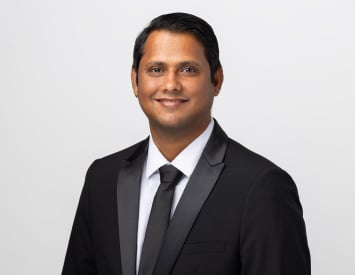Kanhaiya Prasad Jayaswal, a graduate from the Engineering Institute of Technology (EIT), carefully planned his journey from Nepal to Australia to further his engineering career – and succeeded. In this article, he reflects on the cultural and professional shifts that shaped his path.
A Commitment to Growth
Kanhaiya Prasad Jayaswal’s passion for civil and structural engineering was inspired by his early experiences in Nepal, where he saw firsthand the importance of building strong, sustainable structures.
“In Nepal, we often worked with limited resources, and that taught me to be resourceful and adaptable in my designs,” he recalled. This mindset has been crucial in his engineering journey.
Driven to broaden his technical knowledge and apply it in a more advanced and regulated market, Kanhaiya made the bold decision to move to Australia for further study.
“I wanted to be part of a more developed infrastructure sector, where I could expand my understanding of modern construction practices and engineering solutions,” he explained.
He chose the EIT for its Master of Engineering (Civil: Structural), attracted by the flexibility it offered alongside its practical, industry-aligned curriculum.

“EIT’s program allowed me to combine theory with real-world application, ensuring I was prepared to face the challenges in the field,” Kanhaiya said.
The curriculum’s focus on Australian standards and industry technologies aligned perfectly with his desire to enhance his engineering expertise while staying up to date with global best practices.
His studies were more than just academic—they were a pathway to transforming his approach to engineering. “I developed a deeper understanding of engineering principles, and how to use them effectively in a real-world context, particularly in structural analysis and design,” he noted.
This knowledge, combined with practical skills using software like SpaceGass and RCC, has equipped Kanhaiya to take on complex engineering challenges.
Bridging Cultures and Engineering Practices
Adjusting to life and work in Australia presented Kanhaiya with a range of challenges, particularly in understanding the differences in engineering practices between Nepal and Australia.
In Nepal, concrete was predominantly used for construction due to its affordability and suitability in earthquake-prone areas. However, upon moving to Australia, Kanhaiya quickly noticed that engineering in Australia is heavily regulated, with strict adherence to Australian Standards and the National Construction Code.
“Australian engineering practices are very much about consistency, safety, and quality. The use of materials like timber and steel in construction was a new area for me,” Kanhaiya observed.
He has found that these materials, particularly in residential and commercial buildings, offer flexibility, sustainability, and greater resilience to natural disasters like bushfires and cyclones. This transition, while challenging, allowed him to expand his material knowledge and adapt to the more regulated and safety-focused environment in Australia.
Culturally, Kanhaiya’s approach to engineering is informed by his background in Nepal, where community-focused projects are prioritized, especially in rural areas. “In Nepal, engineering projects often address the immediate needs of the community—like safe, affordable housing or disaster-resistant structures,” he said.
This deep sense of responsibility to the end users of his designs remains a key part of his engineering philosophy. Even in his work in Australia, Kanhaiya is mindful of the broader social impact of his designs. “I want to ensure that the projects I work on are not only structurally sound but also serve the needs of the people who will use them.”
His ability to combine the practical, resourceful mindset from his experiences in Nepal with the safety and regulatory-driven approach in Australia has given Kanhaiya a unique perspective in his professional career. It’s this ability to adapt and innovate that makes him a strong contributor to the engineering sector.
Practical Learning and Future Aspirations
The practical nature of Kanhaiya’s studies at EIT, particularly the integration of hand calculations with industry-standard software, was instrumental in shaping his career readiness.
“One of the most impactful aspects of my time at EIT was the opportunity to work on real-world projects that combined manual calculations with software tools. It gave me a solid understanding of the fundamentals while also preparing me to work with the latest technology,” he said.
This hands-on experience has been invaluable as he moved into his professional role in Australia.
Currently, Kanhaiya works as a Civil and Structural Engineer at Silver Wolf Projects, where he applies the skills and knowledge gained at EIT. “The integration of drone technology and software tools into our design and inspection processes has allowed us to ensure the precision and quality of our projects,” Kanhaiya explained.

His ability to blend modern technology with solid engineering practices allows him to deliver projects that are not only compliant with Australian regulations but also innovative in their approach.
Looking ahead, Kanhaiya is keen to tackle more technically complex projects, especially in the field of heritage conservation. “I’m particularly interested in working on the restoration of historical buildings,” he said. “I want to combine modern engineering methods with traditional construction techniques to preserve the architectural integrity of these structures.” His future aspirations reflect his commitment to lifelong learning and his desire to make a meaningful impact on both the engineering profession and the built environment.
For aspiring engineers, Kanhaiya offers this advice: “Stay open to learning and always strive to understand the fundamentals. Engineering is an evolving field, so adaptability and a willingness to innovate are essential.” His journey underscores the importance of practical learning, cultural adaptability, and professional growth in becoming a successful engineer.
Kanhaiya Prasad Jayaswal’s journey from Nepal to Australia and his transformative experience at EIT highlight how an international education, combined with practical learning, can shape an engineer’s career.


